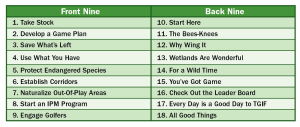Off the Record: How golf improved its environmental game
In the 1980s and ’90s, there was growing concern that golf courses negatively impacted wildlife. Concerns included declining bird species, and malformities in amphibians, to name a few. Environmental groups and journalists referred to golf courses as toxic wastelands absent of wildlife.
The USGA hosted several environmental groups in Washington, D.C., to discuss the perceived impacts of golf on birds, fish, reptiles, amphibians and mammals. One conclusion from the meeting was that there was a lack of peer-reviewed research on the impact of golf courses on wildlife.
Peter Stangel, Ph.D., worked for the National Fish and Wildlife Foundation (NFWF) and participated in the Washington, D.C., meeting. He suggested that the USGA collaborate with the NFWF to fund wildlife research on golf courses.
Golf and birding
Stangel grew up on a golf course. His front yard was just a chip shot from the first green of the Rockport (Texas) Country Club. After school on most days, he would come home, grab a quick snack and head over to the course — to go birding.
Close to the Gulf Coast of Texas, the club had no special management programs to benefit birds and other wildlife, but both were abundant.
“Many of the members, and certainly the groundskeepers, were aware of wildlife and did their best to conserve natural habitats,” Stangel recalls. “The features typical of any course — water hazards such as streams and ponds, brushy edges where rough meets wood and even the wide open fairways — were important to both migratory and resident animals.”

(Graphic: Golfdom Staff)
18 holes of conservation
Stangel was a willing partner and helped the USGA Green Section establish the Wildlife Links Program. This partnership was golf’s first comprehensive investigation of the game’s relationship with wildlife and its habitat. It was established in early 1995 to fund research, management, and education projects needed to provide the game of golf with state-of-the-art information on wildlife management issues.
The USGA contributed $200,000 annually for funding to more than 17 projects. Over the years, nearly a million dollars allowed for a better understanding and management of wildlife conservation on golf courses. In 2006, the USGA published a summary of the funded projects. Wildlife Links: Improving Golf’s Environmental Game has a quote by Albert Einstein on the inside cover: “Look deep into nature, and then you will understand everything better.”
The layout of the Wildlife Links has a list for superintendents to consider. You can find these suggestions at the beginning of the summary in the front nine and the end in the back nine.
The publication is only 21 pages and includes some excellent background information on birds, pollinators, small mammals, amphibians, water features and environmental planning. You can find it on USGA’s website.
Maybe this winter, you can take some time to look through Wildlife Links and implement a few recommendations in 2023.












